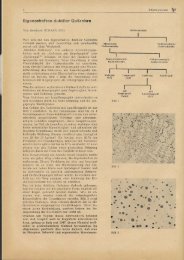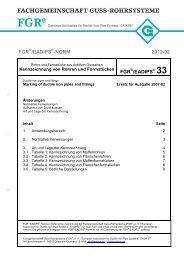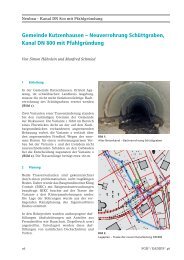Download PDF file
Download PDF file
Download PDF file
- TAGS
- download
- 81.169.135.155
Create successful ePaper yourself
Turn your PDF publications into a flip-book with our unique Google optimized e-Paper software.
Fig. 3<br />
A DN 125 push-in joint being connected on a burst lining<br />
project<br />
Fig. 4<br />
Allowable tractive forces on pipelines in trenchless<br />
installation and replacement techniques<br />
This superiority is also apparent in other heavyduty<br />
applications. The strength of plastic pipes<br />
to resist pressure is limited and because of this<br />
they can be used to only a very limited extent, if<br />
at all, for turbine pipelines for example, which<br />
have to withstand high pressures and generally<br />
have to be installed in topographically difficult<br />
terrain.<br />
Because of the properties of their material and<br />
the different types of external protection available,<br />
ductile iron pipes on the other hand can<br />
be installed without any problems even in rocky<br />
terrain and are even suitable for operating pressures<br />
of more than 100 bars. It is not only in the<br />
case of snow-making systems, which are generally<br />
located in mountainous terrain, and in the<br />
case of pipelines for fire extinguishing water,<br />
which call for a fireproof material for the pipes,<br />
that these advantages become clear. They also<br />
Fig. 5<br />
Ductile iron fittings and valves<br />
apply in principle to any ductile iron pressure<br />
pipeline used in municipal water supply, which<br />
needs good safety margins.<br />
6 To sum up<br />
Ductile iron is a material which can be used in<br />
any pipeline and water management applications<br />
and one which, due to its superior technical<br />
properties, the cost-saving technology used<br />
for its coatings and joints, and the full range of<br />
fittings and valves which is available (Fig. 5), is<br />
able to guarantee long-term safety wherever it<br />
is used. Though a traditional material, cast iron<br />
is in fact more up to date than ever because it<br />
meets the demands of the future for the economical<br />
use of resources and for long-term cost<br />
advantages and therefore for true sustainability.<br />
References<br />
[1] Wegener, Th. and Böge, M: Wirtschaftlichkeitsuntersuchungen<br />
an Rohrleitungen,<br />
GUSSROHR-TECHNIK 41 (2007), p. 45<br />
[2] DVGW-Arbeitsblatt W 400-2<br />
Technical rules of water distribution systems<br />
Part 2: Installation and testing<br />
2004-09<br />
[3] DVGW Technologie Report Nr. 4/2008:<br />
Kunststoffmaterialien in der Gas- und<br />
Wasserversorgung<br />
[4] Neihues, Berthold: DVGW-Schadensstatistik<br />
Wasser. Ergebnisse aus den Jahren 1997<br />
bis 2004<br />
energie | wasser praxis 10 (2006), pp. 18–23<br />
DUCTILE IRON PIPE SYSTEMS 11
















